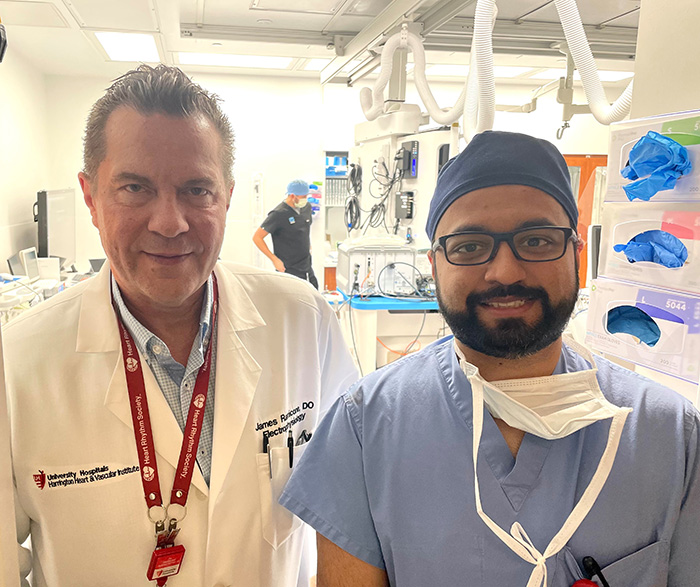The Rhythm of Cardiac Care
November 20, 2023
UH Harrington Heart & Vascular Institute Opens New $1.6 Million EP Lab at UH Parma
UH Harrington Heart & Vascular Institute Update | November 2023
A new Cardiac Electrophysiology Lab at University Hospitals (UH) Parma Medical Center has opened to accommodate patients across the West and South markets seeking treatment for cardiac arrhythmias.
The $1.6 million investment by UH Harrington Heart & Vascular Institute was welcomed by James Ramicone, DO, and Shashank Jain, MD, the two cardiac electrophysiologists who use the lab for their cardiac ablations and implantable devices like pacemakers and internal defibrillators. The larger space contains a new electroanatomical 3D mapping system and fluoroscopy equipment in a lab across the hall from UH Parma’s high-risk cardiac catheterization labs.
 Cardiac electrophysiologists James Ramicone, DO, and Shashank Jain, MD, in UH Parma’s new EP Lab.
Cardiac electrophysiologists James Ramicone, DO, and Shashank Jain, MD, in UH Parma’s new EP Lab.The new state-of-the-art cardiac electrophysiology lab at UH Parma Medical Center is another example of UH Harrington HVI’s commitment to bringing the highest level of quality and technology to Northeast Ohio, according to Mehdi Shishehbor, DO, MPH, PhD, President, Harrington HVI.
“Our volume has steadily increased over the last several years,” says Dr. Ramicone, who sees patients in offices in Parma, Broadview Heights and Medina. “This upgrade was desperately needed. It’s less radiation exposure for the patients, and it’s better for all the people in the room.”
Volumes have steadily grown for treatment of atrial fibrillations, the most common cardiac arrhythmia and a leading cause of stroke. In a cardiac ablation, the cardiac electrophysiologist threads the catheter through the femoral vein, entering the right atrium of the heart. The doctor then makes a trans-septal puncture to reach the left atrium. With 3D mapping, the doctor identifies all structures to ablate and then isolates the pulmonary veins. Remapping is done following the ablation to verify it worked.
“This is a pretty busy lab,” says Dr. Jain, who sees patients in Parma, Fairlawn, Westlake and Ashland and also performs procedures at UH St. John and Cleveland medical centers, as well as UH Samaritan Medical Center, which has more limited capabilities. “From our perspective, we have more space to maneuver and the monitors allow for full use of the mapping system.”
Ablations may be performed on patients experiencing heart rhythm disorders such as:
- Superventricular tachycardia (SVTs) or abnormally fast heart rates
- Premature ventricular contractions (PVCs), or extra, abnormal heartbeats originating in one of the heart’s lower chambers
- Atrial fibrillation (AFib), which is rapid or disorganized electrical impulses stemming from the upper chambers of the heart.
Ablation may be recommended for younger patients, those with heart failure and those who do not want to take medications. Following ablation, patients typically go home the same day, with minimal restrictions for less than a week.
“Atrial fibrillation is by far the most common heart rhythm disturbance for adults,” Dr. Ramicone said. “If a patient is highly symptomatic and in good health, there are some patients for which we can justify ablation as first-line therapy.”
In addition to UH Cleveland Medical Center, UH Harrington HVI has four other dedicated EP labs across the UH system, with others slated for renovation in the coming year:
- West Market – UH Parma, UH Elyria
- East Market – UH Lake West
- South Market – UH Portage


